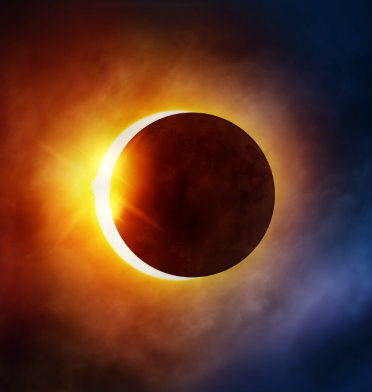On Monday, August 21, onlookers will experience the first total solar eclipse in the continental U.S. since 1979, and the first that can be seen coast to coast since 1918. Hereafter, there won’t be another total solar eclipse in the U.S. for seven years. Solar eclipses are a phenomenon that occurs when the moon passes through the orbit between the sun and Earth.
“When the moon is between the sun and Earth,” says Rachel Wolf, a supernova cosmologist who recently completed her Ph.D. at Penn, “it casts a shadow over the planet. There are two parts of the shadow called the umbra, which is the dark part in the middle, and the penumbra, which refers to the light parts to the side. When you’re in that lighter part of the shade, you’ll see a partial eclipse, and if you’re in the dark part of the shade, in what’s called the path of totality, you’ll see a total eclipse.”
The August 21 eclipse will move from west to east with a path of totality that will start in Oregon and end in South Carolina. Although only observers in those two states and the dozen or so states along the path will be able to see a total eclipse; everyone else in the continental U.S. will still get to see a partial eclipse. In the Philadelphia area, observers will be able to see 79.9 percent of the sun covered by the moon.
“A lot of people are driving to totality,” Wolf says, “but in Philadelphia there’s going to be a great opportunity to see the partial eclipse, which is still really cool when you’re using your solar glasses. You’ll be able to see things like sunspots and activity on the sun. Just seeing the transition and the path of these objects provides a great opportunity to talk about our solar system and the bodies in it.”
Wolf is a member of a science outreach initiative called the Penn Education and Public Outreach in Physics and Astronomy group, which is partnering with the Franklin Institute for their Eclipse Day, an event held at the museum to educate the public about solar eclipses, in particular the importance of eye safety.
“You have to be so careful watching the eclipse,” Wolf says. “You can only look at a total eclipse in the path of totality with safety glasses or solar filters for your camera or telescope. If you’re not wearing protective eye wear, you should not be looking at the eclipse.”
Over the course of the event, there will be hands-on activities and demonstrations ranging from how to build a telescope, to how a solar filter works, to content about stars, the sun, and why eclipses happen. The event will allow people to safely observe the eclipse, which will begin at 1:21 p.m., reach its maximum at 2:44 p.m., and end at 4:01 p.m.
“I think this is an amazing opportunity to get everyone more excited about astronomy, and to talk to people about science and answer questions they might have, even if it’s not directly eclipse-related,” she says. “I hope it will start new kinds of conversations and help people feel comfortable to engage with scientists and learn more.”
Masao Sako, an associate professor of physics and astronomy, is also using this eclipse as an opportunity to educate the public about the phenomena. Sako has arranged a small event at his daughter’s gym and is planning to bring solar glasses, teach the kids to build pinhole cameras from cardboard boxes, and conduct other eclipse-related activities.
David Sliski, a physics and astronomy Ph.D. candidate at Penn, is involved in an expedition led by Williams College astronomer Jay Pasachoff to Willamette’s University in Oregon, where a large group of astronomers will convene to observe, image, and conduct science about the eclipse.
The researchers selected this location because not only is it in the path of totality, but it also has a higher chance of clear skies and is more accessible than other locations due to the fact that it is located on a college campus.
Sliski’s concentration is on the detection of exoplanets, and he hopes to use the eclipse as an opportunity to better understand stars.
Although total solar eclipses happen much more frequently than people typically think, they usually occur in remote locations that are difficult to reach. Sliski, who has never observed a total solar eclipse, says his interest in astronomy stems from his father, who has observed six total eclipses and will accompany him on this expedition.
“Most of the time you have to go to the middle of nowhere,” Sliski says, “but you can drive to this eclipse. It’s great for doing science but the public also gets to see it too, so it’s a really good way to engage them in conversations about astronomy and get them excited about science.”
For tips on how to view the eclipse safely, visit NASA.



